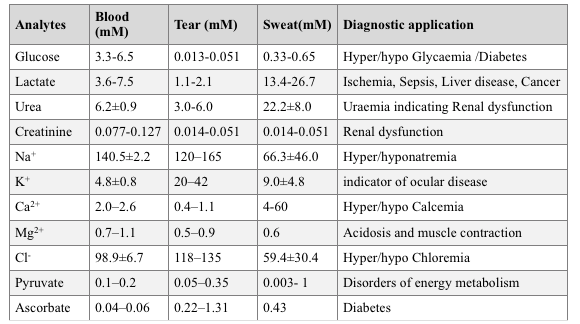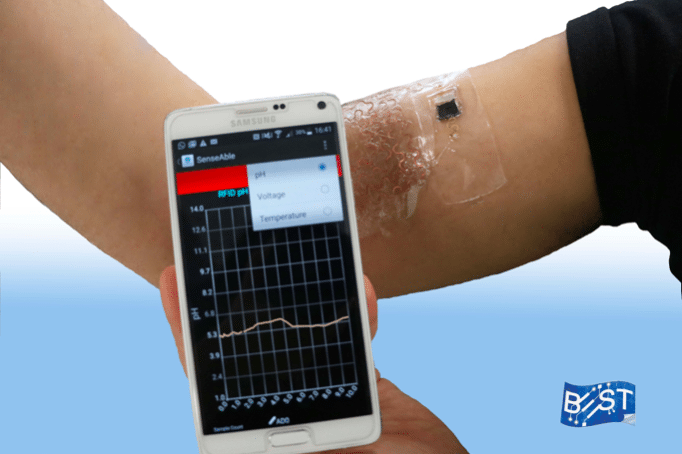
Traditional checks for chronic diseases, such as diabetes, often involve analysis via blood samples and require trained medical staff. However, there would be no need for blood samples if other body fluids such as sweat and tears could do the job.
This is indeed possible, as sweat and tears contain similar analytes (or biomarkers) as blood. Although the concentration of analytes varies with body fluids (Table 1), initial studies indicate they have a good correlation with blood and hence could be used to monitor the diabetes levels. Sweat is particularly attractive as it is readily available or can be extracted on demand with clinical methods such as iontophoresis.
By measuring some of the analytes in the sweat, it is also possible to monitor other diseases such as hypocalcemia, hypochloremia, etc. (Table 1).

Table 1: Analytes in blood, tears, and sweat with their diagnostic significance (Corrie et al., 2015; Farandos et al., 2015; Tinku et al., 2014).
The new technology developed by the UK-based Bendable Electronics and Sensing Technologies (BEST) group at University of Glasgow is a revolutionary step towards a sweat-based, non-invasive monitoring of diabetes. The developed wearable system comprises a pH sensor made from a novel graphite-polyurethane composite, stretchable radio-frequency-identification (RFID) antenna, and a flexible data transmission printed circuit board (PCB). Thanks to a pair of serpentine-shaped interconnecting pieces, the sensor can stretch up to 53 % in length while maintaining strong performance levels, and tests have also shown that the device can withstand being stretched by 30 % up to 500 times.
The device has a quick and stable response time for sweat pH levels ranging between 5 and 9 and can provide results within 8 s. Moreover, substances such as sodium, potassium, and glucose, which are present in sweat, have nearly zero impact on the pH sensor’s performance. The system can wirelessly monitor sweat pH based on Near-Field Communication (NFC) technology.
The non-invasive monitoring with the developed stretchable wearable system and the wireless power and data transmission will enable self-health management of chronic diseases and revolutionize the way these diseases are currently monitored. The electronics on flexible and stretchable substrates in the new platform allows the developed wearable systems to conform to body parts and improves the reliability of data collection. The step towards wireless sweat monitoring has been successfully demonstrated in a recently published paper in the journal Biosensors and Bioelectronics.
Unlike other wireless systems that transmit data via Bluetooth technology, the new system can transmit its data without using external power. Based on the NFC technology, the pH data is sent to a smartphone through an RFID antenna. The sensor performs reliably up to 20 % strain. The group has also developed a dedicated smartphone app called SenseAble, which allows the user to track their pH levels in real time, as illustrated in Fig.1.

Fig.1 Representative image of sweat pH display on the smartphone while wearing the stretchable sweat pH sensing patch. (Credit: Ravinder Dahiya)
The group is currently extending this work by including additional sensors capable of measuring glucose, ammonia, and urea. It is believed that in near future, the multi-biomarkers monitoring system will be on the market.








